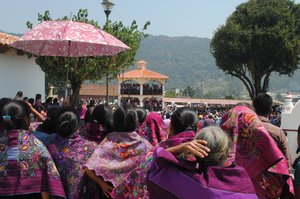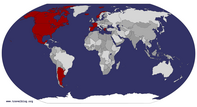Advertisement
Published: June 26th 2015

 Purple
Purple
Women watching political speeches in ZinacantanMaria Chiara and I were captivated by what we'd heard of San Cristobal de Las Casas - even the name itself conjures up something far flung and exotic. It's a city in Chiapas in Southern Mexico, well into the tropics but high altitude as well, a colonial town with gaily painted houses, churches on every square, pleasantly mild temperatures all year round and crystalline mountain air.
But the issue was getting there. We were in Quintana Roo in the North East of the Yucatan Peninsula, and were contemplating a long drive in a hire car through endless flatlands of scrubby jungle. That monotony would have finally be broken when we got to Chiapas and the mountains. Unfortunately, as well as beautiful vistas one would have to contend with potential ambushes from local bandits. We checked - this does happen! So in the end we opted for a night bus instead. More a night
and day bus really, considering the journey ended up being 19 hours long. As we ascended from the hot jungle we passed banana plantations and numerous villages where virtually every family had a small general store as its frontage. Only towards the end of the journey did
the weather start to cool somewhat and the lush tropical vegetation transformed to more temperate: pine trees, vegetable patches and European looking flowers.
San Cristobal is a blessed place. I've visited many a historic, colonial town, and the general pattern is that the centre is beautiful but walk a few blocks outwards and the town will become progressively uglier. In San Cristobal that never seemed to happen - wherever we wandered there were pretty streets with brightly painted squat houses, churches with imposing Mexican baroque façades and piazzas brimming flowers.
This part of Mexico is a centre of coffee and chocolate production. What's not to like about a place that makes both of these glorious products? Mexicans can make fine coffee beans but regretfully they don't make a good cup of coffee. Being situated dangerously close to the USA they have picked up bad habits, coffee rarely being seen out of anything other than a percolator. What a travesty! They do other things very well though: on quiet street corners men had carts selling impossibly perfect looking mangos slices in cups which they drenched in a sweet chilli sauce. So good.
As we were without a car
we took an organised tour everyday, which was great value and exceptionally easy. Our first day's adventure was being driven to two native villages in the valleys beyond San Cristobal. According to the Mexican constitution citizens have the right to freely roam their own country, with one or two exceptions. As ethnic Mayan villages such as Zinacantan predate the constitution, out of respect to their customs the Mexican government allows them to make their own laws, and they have decided to charge people to visit their village! Fortunately as an experience it was well worth the entry charge. On this particular day there were candidates making speeches as prospective political representatives, and so virtually every villager was in the main square dressed in their Sunday best. One of Zinacantan's two main industries is textile making, and they seem to save the best textiles for themselves. Most people were dressed in elaborate hand-made wool tunics with floral designs, and the fashion of the last few years has been the colour PURPLE. That may sound like a challenging look for an adult male to pull off, but they managed it extremely well, and generally capped off the ensemble with a cowboy hat.
It was a strong look.
Their main church was another story. Here they were showing off their other main industry: flower cultivation. The entire church was decked out in flowers of all shapes and sizes, there must have been several thousand in total. Apparently whoever is governor will virtually bankrupt themselves with privately funded flower displays throughout the year they're in power, as it affords them such kudos in the town they and their families will be regarded as eminent citizens for years to come. Another custom is that there will be priests praying at all times, day and night. We saw one such priest in a chapel sitting dead straight but deeply asleep, obviously recovering from the dreaded prayer night-shift.
The second village we visited was San Juan Chamula. The place was called Chamula by the Mayans and when the Spanish turned up they added the "San Juan" bit - this is very typical. I'm not sure if it was due to a fluke in the weather, but the atmosphere changing between Zinacantan and Chamula was uncanny. Where the first was bright and filled with colour, the second was dour, grey and slightly intimidating. Rather than the
purple tunics, here the traditional dress of the woman was to where shaggy black woollen skirts.
Our tour guide was very clear that we should take heed of the rule not to take photos in the main church. He also said: no matter what you do, do not mess with anyone from Chamula, they are very tough people. The government has allowed the locals to administer their own laws with their own forms of punishment. A murderer can end up murdered themselves, and a thief can end up with his hand chopped off. So, if they tell us we can't take photos in their church, I'm totally cool with that.
The church was unforgettable anyway, photos weren't necessary. The architecture was as one would expect in a Spanish colonial town, laid out in the shape of a cross with white-painted adobe walls. There was an effigy of every saint you could imagine fringing the communal space, with candles burning in front of each, depending on what form of blessing or luck the churchgoer needed. The most extraordinary feature of the church was that the entire floor was covered in pine nettles. Apparently in pre-Columbian times the pine forest
was considered to be holy, so when the Spanish built churches, the locals quite literally brought the forest in with them. There were no seats. Locals sat cross-legged on the pine needle floor in circles, including mothers breast feeding. Each circle of people will have employed a holy man/shaman who would be saying prayers on their behalf, lighting and manipulating more candles. The most bizarre aspect of all was there were many eggs being used by the holy men. if you are sick, apparently an egg will absorb that sickness. In more severe cases of sickness, live chickens would be used instead. Well, they were live chickens at the start of the process at least. The odd tourist like us walking around looking a bit shell shocked.
Our next adventure was to the Sumidero Canyon. No one bothered to tell us (and we didn't bother to check) the altitude of this canyon. We had assumed it was even higher than we were already, so dressed up warmly. We had made a rare tactical error; San Cristobal is over 2000m above sea level, and the canyon less than 500m, so by the time we got to the river where our
trip proper was about to begin, it was stiflingly hot and humid and we had to remove clothes urgently. The boat took us a few kilometres down a wide river that gradually narrowed, and as it did so, the mountains on either side got gradually steeper and more spectacular. We saw all sorts of birds, crazy rock formations, and best of all: two impressively big crocodiles.
After this tour we were dropped off for an hour's wander in the town of Chiapa de Corso. This was the HOTTEST PLACE I HAVE EVER BEEN! I suppose it was only 40 degrees C, but it was humid as well, as I'm simply not built for such extremes. I remember when I was a kid in Auckland on hot days in summer I would get irritated with my mother perpetually groaning. In Chiapa di Corso poor Maria Chiara had to endure
me doing the groaning. Our route around the town was mainly dictated by where we could find the most shade, and the only thing of any particular interest was the availability of ice cream or fruit juice.
We were so impressed by San Cristobal we ended up staying an extra
night, but we had to drag ourselves away in the end. Our third and last organised tour was visiting beauty spots on the way back down the mountains. The tour van stopped at the bottom of the hills at a large buffet breakfast restaurant. After pancakes, cereal, bacon, black beans and tacos, we were much recovered from the early start. It actually turned out that being in a communal vehicle didn't make us any less vulnerable to the bandits after all; at one point the 150 or so people in the restaurant were summoned by their drivers. One bus and six vans all departed simultaneously in a convoy, with a police car as escort!
We safely arrived in the two beauty spots, Misol-Ha waterfall and the absolutely stunning Agua Azul. As the name suggests this is a stretch of river where the water is blue. Really, really blue. We were by now very much back in the heat of the jungle, so this spot was just too perfect for a refreshing dip.
It was once we arrived in Palenque in heart of the lowland jungle that the next phase of our Mexican odyssey began - with our first

 Art Shot
Art Shot
In our hotel in San Cristobalvisit to a Mayan ruin. That's a story for our last instalment of our Mexican adventures... see you in the next blog!
Advertisement
Tot: 0.087s; Tpl: 0.014s; cc: 15; qc: 32; dbt: 0.036s; 1; m:domysql w:travelblog (10.17.0.13); sld: 1;
; mem: 1.1mb

























D MJ Binkley
Dave and Merry Jo Binkley
Mexico
Beautiful